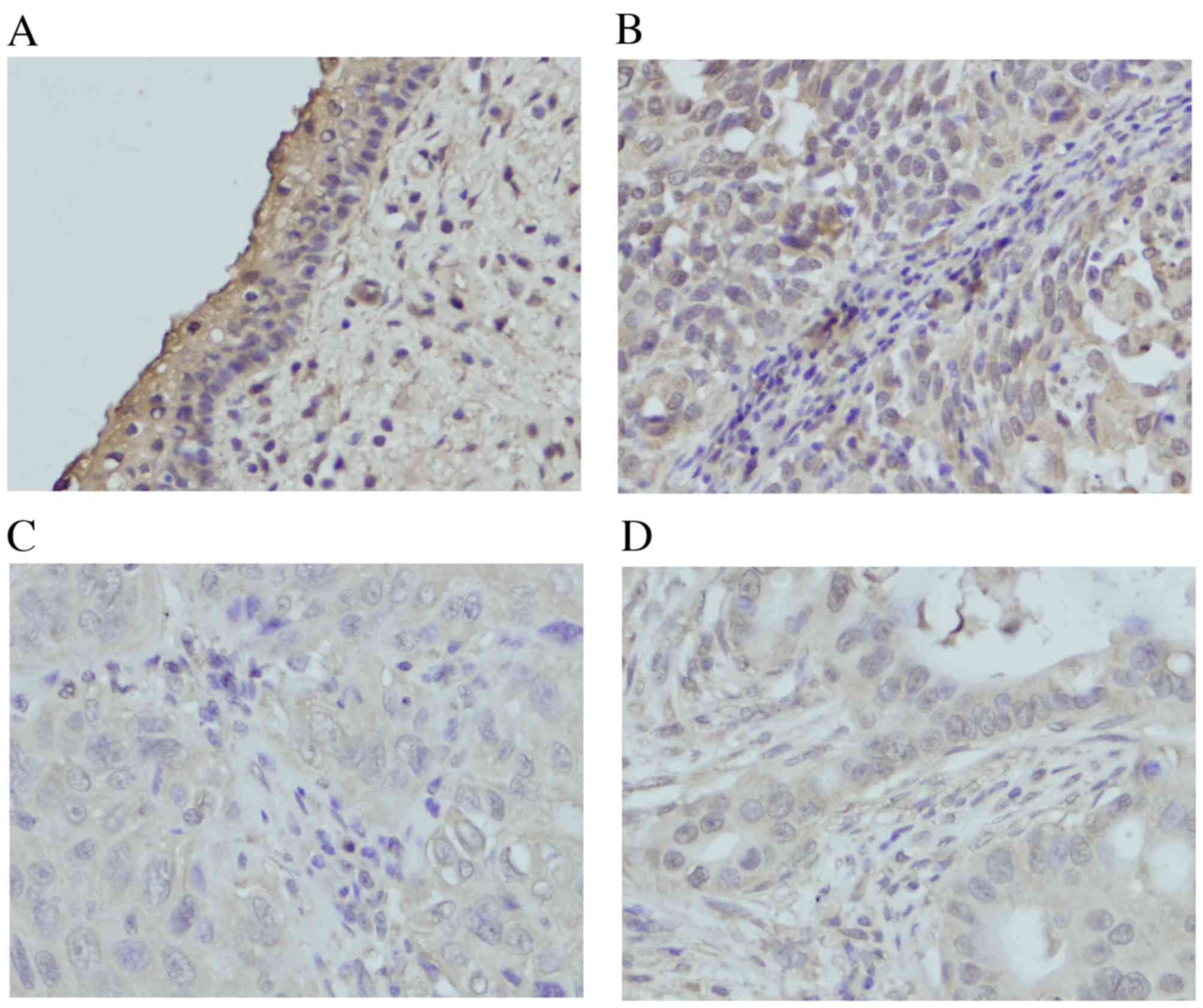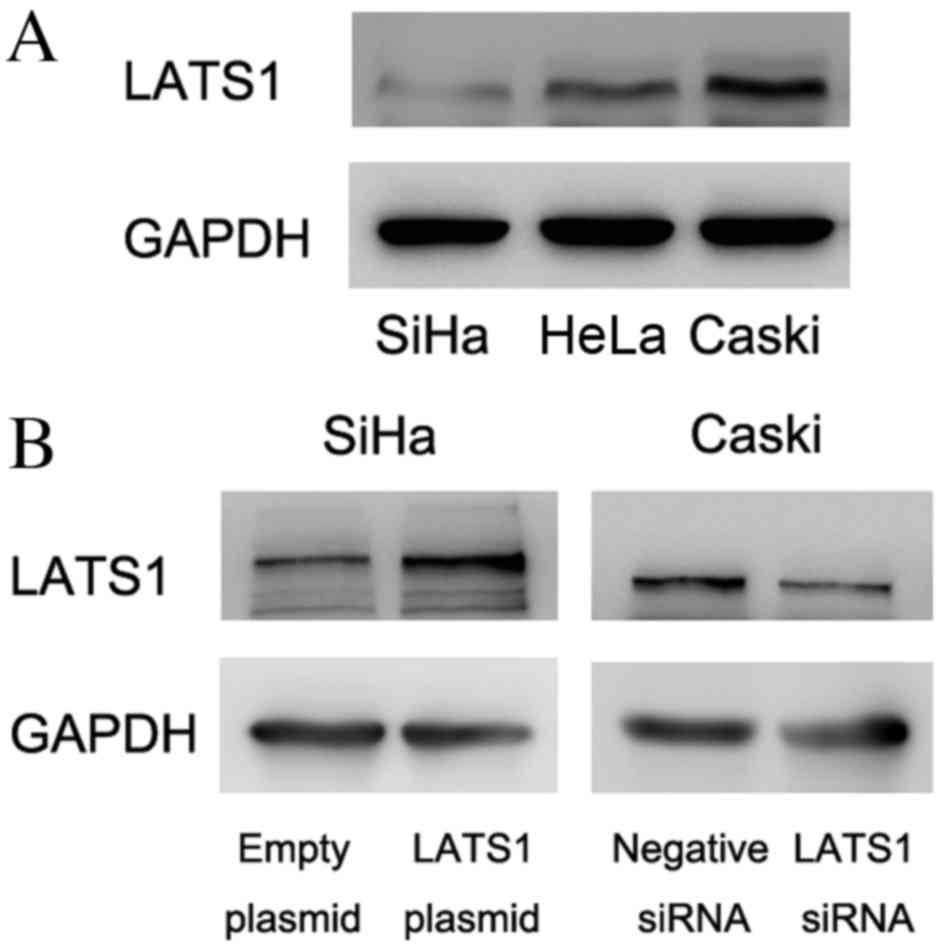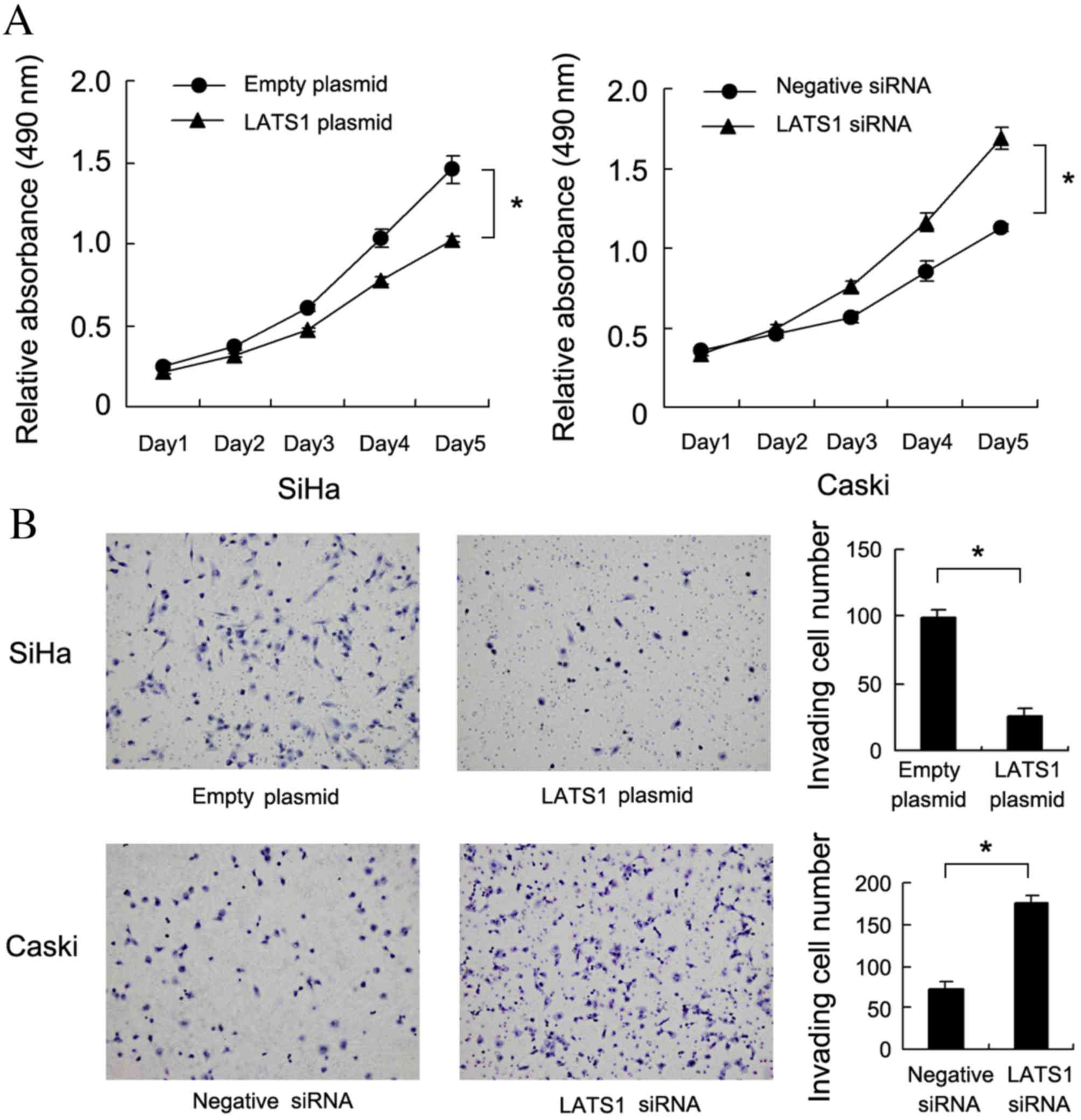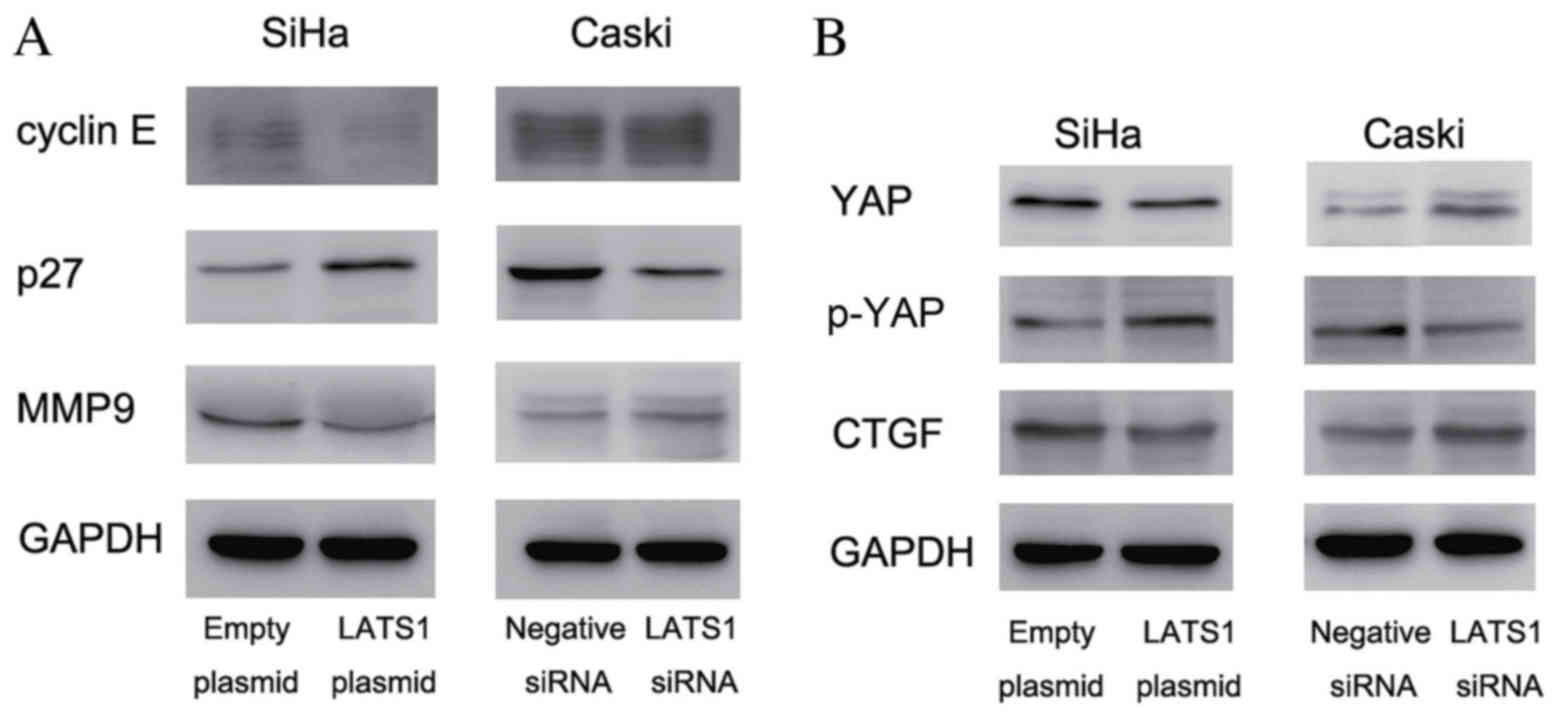|
1
|
Siegel R, Ma J, Zou Z and Jemal A: Cancer
statistics, 2014. CA Cancer J Clin. 64:9–29. 2014. View Article : Google Scholar : PubMed/NCBI
|
|
2
|
Song C, Zhu S, Wu C and Kang J: Histone
deacetylase (HDAC) 10 suppresses cervical cancer metastasis through
inhibition of matrix metalloproteinase (MMP) 2 and 9 expression. J
Biol Chem. 288:28021–28033. 2013. View Article : Google Scholar : PubMed/NCBI
|
|
3
|
St John MA, Tao W, Fei X, Fukumoto R,
Carcangiu ML, Brownstein DG, Parlow AF, McGrath J and Xu T: Mice
deficient of Lats1 develop soft-tissue sarcomas, ovarian tumours
and pituitary dysfunction. Nat Genet. 21:182–186. 1999. View Article : Google Scholar : PubMed/NCBI
|
|
4
|
Huntoon CJ, Nye MD, Geng L, Peterson KL,
Flatten KS, Haluska P, Kaufmann SH and Karnitz LM: Heat shock
protein 90 inhibition depletes LATS1 and LATS2, two regulators of
the mammalian hippo tumor suppressor pathway. Cancer Res.
70:8642–8650. 2010. View Article : Google Scholar : PubMed/NCBI
|
|
5
|
Furth N, Bossel B, en-Moshe N, Pozniak Y,
Porat Z, Geiger T, Domany E, Aylon Y and Oren M: Down-regulation of
LATS kinases alters p53 to promote cell migration. Genes Dev.
29:2325–2330. 2015. View Article : Google Scholar : PubMed/NCBI
|
|
6
|
Visser S and Yang X: LATS tumor
suppressor: A new governor of cellular homeostasis. Cell Cycle.
9:3892–3903. 2010. View Article : Google Scholar : PubMed/NCBI
|
|
7
|
Morinaga N, Shitara Y, Yanagita Y, Koida
T, Kimura M, Asao T, Kimijima I, Takenoshita S, Hirota T, Saya H
and Kuwano H: Molecular analysis of the h-warts/LATS1 gene in human
breast cancer. Int J Oncol. 17:1125–1129. 2000.PubMed/NCBI
|
|
8
|
Wierzbicki PM, Adrych K, Kartanowicz D,
Stanislawowski M, Kowalczyk A, Godlewski J, Skwierz-Bogdanska I,
Celinski K, Gach T, Kulig J, Korybalski B and Kmiec Z:
Underexpression of LATS1 TSG in colorectal cancer is associated
with promoter hypermethylation. World J Gastroenterol.
19:4363–4373. 2013. View Article : Google Scholar : PubMed/NCBI
|
|
9
|
Xu ZP, Zhu JS, Zhang Q and Wang XY: A
breakdown of the Hippo pathway in gastric cancer.
Hepatogastroenterology. 58:1611–1617. 2011. View Article : Google Scholar : PubMed/NCBI
|
|
10
|
Lin XY, Zhang XP, Wu JH, Qiu XS and Wang
EH: Expression of LATS1 contributes to good prognosis and can
negatively regulate YAP oncoprotein in non-small-cell lung cancer.
Tumour Biol. 35:6435–6443. 2014. View Article : Google Scholar : PubMed/NCBI
|
|
11
|
Xu B, Sun D, Wang Z, Weng H, Wu D, Zhang
X, Zhou Y and Hu W: Expression of LATS family proteins in ovarian
tumors and its significance. Hum Pathol. 46:858–867. 2015.
View Article : Google Scholar : PubMed/NCBI
|
|
12
|
Puppo P, Conti G, Francesca F, Mandressi A
and Naselli A: AURO. it guideline committee: New Italian guidelines
on bladder cancer, based on the World Health Organization 2004
classification. BJU Int. 106:168–179. 2010. View Article : Google Scholar : PubMed/NCBI
|
|
13
|
Bocchi EA, Tanigawa RY, Brandão SM, Cruz
F, Issa V, Ayub-Ferreira S, Chizzola P, Souza G, Fiorelli AI, Bacal
F, et al: Immunohistochemical quantification of inflammatory cells
in endomyocardial biopsy fragments after heart transplantation: A
new potential method to improve the diagnosis of rejection after
heart transplantation. Transplant Proc. 46:1489–1496. 2014.
View Article : Google Scholar : PubMed/NCBI
|
|
14
|
Roussel AJ, Knol AC, Bourdeau PJ and Bruet
V: Optimization of an immunohistochemical method to assess
distribution of tight junction proteins in canine epidermis and
adnexae. J Comp Pathol. 150:35–46. 2014. View Article : Google Scholar : PubMed/NCBI
|
|
15
|
Justice RW, Zilian O, Woods DF, Noll M and
Bryant PJ: The Drosophila tumor suppressor gene warts encodes a
homolog of human myotonic dystrophy kinase and is required for the
control of cell shape and proliferation. Genes Dev. 9:534–546.
1995. View Article : Google Scholar : PubMed/NCBI
|
|
16
|
Tao W, Zhang S, Turenchalk GS, Stewart RA,
St John MA, Chen W and Xu T: Human homologue of the Drosophila
melanogaster lats tumour suppressor modulates CDC2 activity. Nat
Genet. 21:177–181. 1999. View
Article : Google Scholar : PubMed/NCBI
|
|
17
|
Ji T, Liu D, Shao W, Yang W, Wu H and Bian
X: Decreased expression of LATS1 is correlated with the progression
and prognosis of glioma. J Exp Clin Cancer Res. 31:672012.
View Article : Google Scholar : PubMed/NCBI
|
|
18
|
Takahashi Y, Miyoshi Y, Takahata C,
Irahara N, Taguchi T, Tamaki Y and Noguchi S: Down-regulation of
LATS1 and LATS2 mRNA expression by promoter hypermethylation and
its association with biologically aggressive phenotype in human
breast cancers. Clin Cancer Res. 11:1380–1385. 2005. View Article : Google Scholar : PubMed/NCBI
|
|
19
|
Chen KH, He J, Wang DL, Cao JJ, Li MC,
Zhao XM, Sheng X, Li WB and Liu WJ: Methylation-associated
inactivation of LATS1 and its effect on demethylation or
overexpression on YAP and cell biological function in human renal
cell carcinoma. Int J Oncol. 45:2511–2521. 2014.PubMed/NCBI
|
|
20
|
Visser-Grieve S, Zhou Z, She YM, Huang H,
Cyr TD, Xu T and Yang X: LATS1 tumor suppressor is a novel
actin-binding protein and negative regulator of actin
polymerization. Cell Res. 21:1513–1516. 2011. View Article : Google Scholar : PubMed/NCBI
|
|
21
|
Hao Y, Chun A, Cheung K, Rashidi B and
Yang X: Tumor suppressor LATS1 is a negative regulator of oncogene
YAP. J Biol Chem. 283:5496–5509. 2008. View Article : Google Scholar : PubMed/NCBI
|
|
22
|
Xia H, Qi H, Li Y, Pei J, Barton J,
Blackstad M, Xu T and Tao W: LATS1 tumor suppressor regulates G2/M
transition and apoptosis. Oncogene. 21:1233–1241. 2002. View Article : Google Scholar : PubMed/NCBI
|
|
23
|
Lopez-Beltran A, MacLennan GT and
Montironi R: Cyclin E as molecular marker in the management of
breast cancer: A review. Anal Quant Cytol Histol. 28:111–114.
2006.PubMed/NCBI
|
|
24
|
Guan X, Wang Y, Xie R, Chen L, Bai J, Lu J
and Kuo MT: p27 (Kip1) as a prognostic factor in breast cancer: A
systematic review and meta-analysis. J Cell Mol Med. 14:944–953.
2010. View Article : Google Scholar : PubMed/NCBI
|
|
25
|
Zubillaga-Guerrero MI, Alarcón-Romero Ldel
C, Illades-Aguiar B, Flores-Alfaro E, Bermúdez-Morales VH, Deas J
and Peralta-Zaragoza O: MicroRNA miR-16-1 regulates CCNE1 (cyclin
E1) gene expression in human cervical cancer cells. Int J Clin Exp
Med. 8:15999–16006. 2015.PubMed/NCBI
|
|
26
|
Prasad SB, Yadav SS, Das M, Modi A, Kumari
S, Pandey LK, Singh S, Pradhan S and Narayan G: PI3K/AKT
pathway-mediated regulation of p27(Kip1) is associated with cell
cycle arrest and apoptosis in cervical cancer. Cell Oncol (Dordr).
38:215–225. 2015. View Article : Google Scholar : PubMed/NCBI
|
|
27
|
van De Putte G, Holm R, Lie AK, Tropé CG
and Kristensen GB: Expression of p27, p21, and p16 protein in early
squamous cervical cancer and its relation to prognosis. Gynecol
Oncol. 89:140–147. 2003. View Article : Google Scholar : PubMed/NCBI
|
|
28
|
Zhu D, Ye M and Zhang W: E6/E7oncoproteins
of high risk HPV-16 upregulate MT1-MMP, MMP-2 and MMP-9 and promote
the migration of cervical cancer cells. Int J Clin Exp Pathol.
8:4981–4999. 2015.PubMed/NCBI
|
|
29
|
Pahne-Zeppenfeld J, Schröer N,
Walch-Rückheim B, Oldak M, Gorter A, Hegde S and Smola S: Cervical
cancer cell-derived interleukin-6 impairs CCR7-dependent migration
of MMP-9-expressing dendritic cells. Int J Cancer. 134:2061–2073.
2014. View Article : Google Scholar : PubMed/NCBI
|
|
30
|
Roomi MW, Monterrey JC, Kalinovsky T, Rath
M and Niedzwiecki A: In vitro modulation of MMP-2 and MMP-9 in
human cervical and ovarian cancer cell lines by cytokines, inducers
and inhibitors. Oncol Rep. 23:605–614. 2010.PubMed/NCBI
|
|
31
|
He C, Mao D, Hua G, Lv X, Chen X,
Angeletti PC, Dong J, Remmenga SW, Rodabaugh KJ, Zhou J, et al: The
Hippo/YAP pathway interacts with EGFR signaling and HPV
oncoproteins to regulate cervical cancer progression. EMBO Mol Med.
7:1426–1449. 2015. View Article : Google Scholar : PubMed/NCBI
|
|
32
|
Zhen Y, Ye Y, Yu X, Mai C, Zhou Y, Chen Y,
Yang H, Lyu X, Song Y, Wu Q, et al: Reduced CTGF expression
promotes cell growth, migration, and invasion in nasopharyngeal
carcinoma. PLoS One. 8:e649762013. View Article : Google Scholar : PubMed/NCBI
|
|
33
|
Tsai HC, Su HL, Huang CY, Fong YC, Hsu CJ
and Tang CH: CTGF increases matrix metalloproteinases expression
and subsequently promotes tumor metastasis in human osteosarcoma
through down-regulating miR-519d. Oncotarget. 5:3800–3812. 2014.
View Article : Google Scholar : PubMed/NCBI
|














